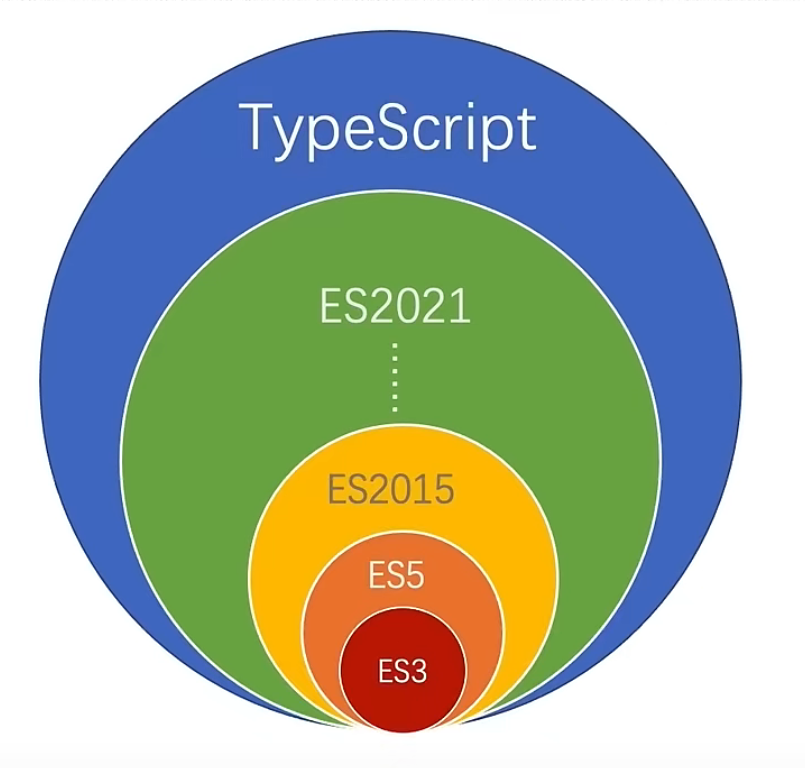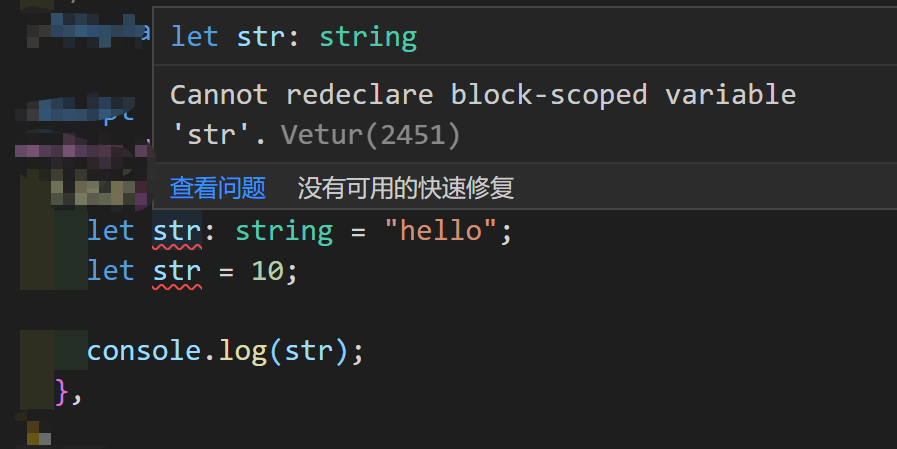1, Overview
- Concept: TypeScript is a superset of JavaScript and supports ES6, Microsoft and open source programming languages
- characteristic:
- Debugging and maintenance: there are input prompts, syntax and logic error warnings
- Type restriction: compilation error
- Write multi version output at one time: it can be compiled into various JS versions (ES3\ES5...)
- Scope: that is, the compatible version syntax is also legal in TS

2, Data type
2.1 compilation tools
- Online compiler: Portal
- vue use
- Add single file: < script > tag with lang="ts" attribute
- typescript: when creating a project
- Uninitialized variables: errors will be reported directly during compilation
2.2 basic data type
2.2.1 string, number, Boolean
- character string
// Writing 1 (common): ts type inference let name_temp= 'duke'; // Writing method 2: with type comments, single and double quotation marks are OK let name: string = "duke"; // Template string: the backquote is above the tab key let sentence: string = `my name is ${ name + '.' }`; // Output: duke console.log(name); // Output: my name is duke console.log(sentence); - number
// Writing 1 (common): ts type inference let num_temp = 3.14; // Writing method 2: with type annotation let num: number = 100; // Output: 101 console.log(num+1);
- Boolean value
// Writing 1 (common): ts type inference let bool_temp = false; // Writing method 2: with type annotation let bool: boolean = true; // Output: true console.log(bool);
ts type inference: by default, ts infers the variable type according to the initialization value. After initialization, the variable type is fixed
- Real time error reminder (no reminder in pure js runtime)

2.3 composite type
2.3.1 array, tuple and enumeration
- Array: the storage sub data type is the same
// Method 1 (commonly used): initialization upon declaration, which can be an empty array [] let arr0: number[] = [0, 1]; // Method 2: declaration, initialization and separation let arr1: number[]; arr1 = [1]; // Output: (2) [0,1], 2 is the length of the array console.log(arr0); // Output: 1 console.log(arr1[0]); // If it is miscellaneous, it is written as follows. The type of a is object (see Section 2.4) let a = [1, "abc"]; for (let i of a) { console.log(i); console.log(typeof i); } - Tuple: the stored sub data is not necessarily the same
let person: [string, number]; // If the number is wrong, an error will be reported: person = ["duke", 18, 3]; // Position error: person = [18, "duke"]; person = ["duke", 18]; person[0] = "Jack"; // Output: (2) ['Jack', 18] console.log(person); // Deconstruction tuple let [name, age] = person; // Output: 18 console.log(age);
Deconstruction: ES6 syntax, applicable to various composite types let [a, B,...]= object
- enumeration
enum Color { Red, Green = 3, Blue, } // Enumeration assignment let sun: Color = Color.Red; // Output: 0 console.log(sun); // Output: 4 console.log(Color.Blue); // Output: number console.log(typeof Color.Blue);
2.3.2 object
- Conventional implementation
let stu = { name: "duke", age: 18, }; // Output: object console.log(typeof stu); - Interface implementation
// Interface keyword: interface, which can also be used to define objects. I is added before the interface interface Person { name: string; age: number; }; // Object Assignment let duke: Person = { name: "duke", age: 18, }; // Defines an array in which each element is an object let Stu: Person[]; Stu = [duke]; // Output: {name: 'duke', age: 18} console.log(Stu[0]);
2.4 other types
- null type
- Definition: setting to "null" value can be understood as setting a pointer to null
- Code example, commonly used in basic type initialization
// Union type: the symbol "|", either of which can be used let x: string | null ; x = null; // Output: object console.log(typeof x); // Output: null console.log(x);
- undefine type
- Definition: undefined, that is, the pointer is not set, and the variable type and value are undefined. It is often used on optional parameters of functions
- Code example
let x: string | undefined; // x = undefined; // Output: undefined console.log(typeof x); // Output: undefined console.log(x);
- Void type: if the function has no return statement, the return value type is void
- Any type: any type, that is, jump out of the type check, and do not use it for no special reason
- Object type: object type. Because everything in JS is an object, there is no special reason to use it
3, Function
3.1 conventional writing
- Code example
// Compared with JS, only type restrictions are added to the parameters, // Limit of return value type: void is defined if there is no return value, and type estimation is adopted if there is a return value but it is not specified const test0 = (name: String, age: Number): string => { return "name is " + name; }; console.log(test0("duke", 18)); // With default parameters: the default parameters must be placed on the right, and the return value type is presumed const test1 = (name: String, age: Number = 18) => { return "age is " + age; }; test1("duke"); // With optional parameters: optional parameters must be placed on the right // Here, the age type is implicitly defined | number const test2 = (name: String, age?: Number) => { return "age is " + age; }; test2("duke"); // Output: age is undefined // With expansion: the expansion is placed to the right const test3 = (...name: string[]) => { return "second is:" + name[1]; }; console.log(test3("duke", "jack", "york"));
3.2 expansion character
- Definition:, In function test3, the expansion character is used to put the three incoming strings into the character array name one by one; ES6 new syntax for expanding all items in an iteratable object
- Code example
const a = [2, 3]; let b: number[] = []; // Array a is expanded into two, three and four numbers, not two, three and four // b.push(...a); b = [1, ...a, 4]; // Output: (4) [1, 2, 3, 4] console.log(b); b.push(...a); // Output: (6) [1, 2, 3, 4, 2, 3] console.log(b);
4, Interface
- Basic Usage
// Interface definition interface IPerson { name: string; age: number; } // Interface inheritance interface IStudent extends IPerson { sayHi: () => string; } // Interface assignment let duke: IStudent = { name: "duke", age: 18, sayHi: (): string => { return "Hi there"; }, }; // Output: duke console.log(duke.name); // Output: Hi there console.log(duke.sayHi());
Previous article: a preliminary study of javascript (V) -- BOM